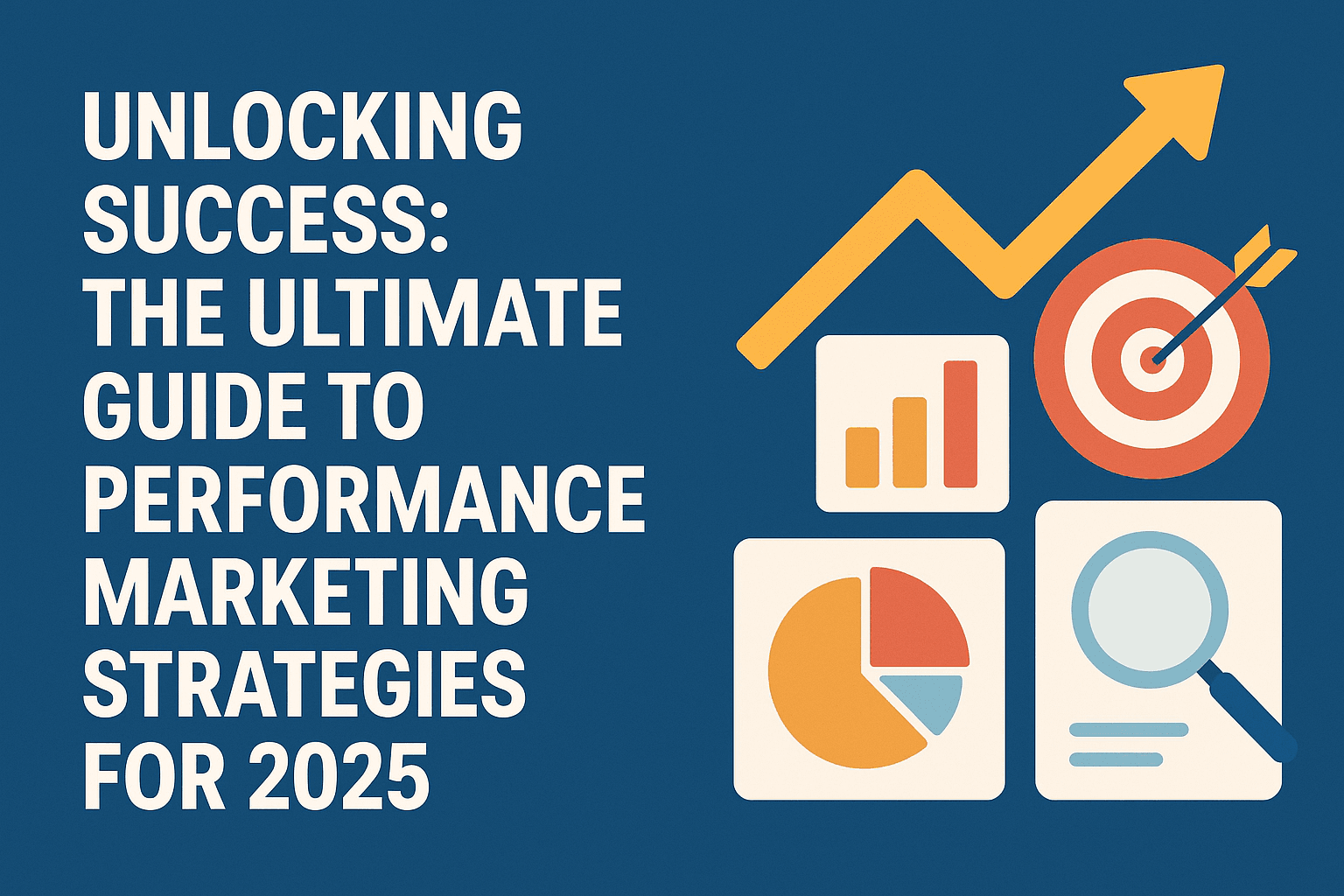Unlocking Success: The Ultimate Guide to Performance Marketing Strategies for 2025

In an increasingly competitive digital landscape, mastering performance marketing is no longer optional—it’s imperative for success. As we look ahead to 2025, businesses must embrace innovative strategies that drive measurable results and maximize ROI. This ultimate guide will equip marketers with the insights needed to unlock the full potential of performance marketing. From harnessing the power of data analytics to leveraging the latest technologies, we’ll explore actionable tactics that can elevate your campaigns and connect you with your target audience more effectively than ever before. With new trends constantly emerging, staying ahead of the curve is crucial, and this guide serves as your roadmap to navigating the complexities of performance marketing. Whether you’re a seasoned professional or just starting, you’ll find valuable tips and strategies to enhance your marketing efforts. Get ready to transform the way you approach performance marketing and achieve extraordinary results by 2025!
Key Trends Shaping Performance Marketing in 2025
As we approach 2025, the landscape of performance marketing is undergoing significant transformations driven by technological advancements, evolving consumer behaviors, and increasing demand for measurable results. One of the most prominent trends is the rise of artificial intelligence (AI) and machine learning. These technologies are revolutionizing how marketers analyze data, personalize content, and optimize campaigns in real-time. With AI algorithms, marketers can predict consumer behavior more accurately, automate repetitive tasks, and deliver highly targeted advertisements that resonate with their audience. This shift towards AI-driven marketing is not just a trend; it’s a fundamental change in how marketing strategies are formulated and executed.
Another trend that is shaping the future of performance marketing is the growing importance of data privacy and ethical marketing practices. With the introduction of stringent data protection regulations like GDPR and CCPA, marketers must navigate the fine line between personalization and privacy. Consumers are becoming increasingly aware of how their data is being used, and transparency has become a key factor in building trust. This means that performance marketers need to adopt ethical data collection and usage practices, ensuring that they are compliant with regulations while still delivering personalized experiences to their audience. The emphasis on ethical marketing is likely to grow as consumers demand more control over their personal information.
The third trend that will significantly impact performance marketing in 2025 is the integration of omnichannel strategies. In today’s digital age, consumers interact with brands across multiple channels and devices. To maximize ROI, marketers need to create seamless and consistent experiences across all touchpoints, from social media and email to in-app and in-store interactions. This requires a comprehensive understanding of the customer journey and leveraging data to ensure that each interaction is relevant and engaging. By embracing an omnichannel approach, marketers can connect with their audience more effectively, improve customer retention, and drive higher conversions.
Understanding the Performance Marketing Funnel
The performance marketing funnel is a conceptual model that outlines the stages a consumer goes through before making a purchase. It helps marketers understand how to attract, engage, and convert potential customers at each stage of their journey. The funnel typically consists of four main stages: awareness, consideration, conversion, and retention. Each stage requires different strategies and tactics to move prospects closer to becoming loyal customers.
The awareness stage is where potential customers first become aware of your brand or product. At this stage, the goal is to capture their attention and generate interest. This can be achieved through various performance marketing channels such as display advertising, social media campaigns, and content marketing. The key is to create compelling and informative content that resonates with your target audience and encourages them to learn more about your brand.
Once potential customers are aware of your brand, they move into the consideration stage. Here, they are actively evaluating their options and comparing different products or services. To influence their decision, marketers need to provide valuable information that addresses their needs and pain points. This can include product reviews, case studies, testimonials, and targeted email campaigns. The focus should be on building trust and demonstrating how your product or service can solve their problems better than the competition.
The conversion stage is where prospects take the desired action, such as making a purchase or signing up for a service. At this stage, it’s crucial to remove any barriers to conversion and provide a seamless user experience. This can involve optimizing landing pages, offering special promotions, and using retargeting ads to remind prospects of their interest. Finally, the retention stage focuses on keeping customers engaged and encouraging repeat business. This can be achieved through personalized email campaigns, loyalty programs, and excellent customer service. By understanding and optimizing each stage of the performance marketing funnel, marketers can drive higher conversions and build long-term customer relationships.
Essential Performance Marketing Channels
Performance marketing encompasses a variety of channels that help businesses reach their target audience and achieve specific goals. One of the most effective channels is search engine marketing (SEM), which includes both paid search (PPC) and organic search (SEO). SEM allows marketers to target users who are actively searching for products or services related to their business. By bidding on relevant keywords and optimizing their website for search engines, businesses can drive high-quality traffic to their site and increase their chances of conversion.
Social media advertising is another powerful performance marketing channel. Platforms like Facebook, Instagram, LinkedIn, and Twitter offer advanced targeting options that allow marketers to reach specific demographics, interests, and behaviors. With the ability to create highly engaging and visually appealing ads, social media advertising can generate significant brand awareness and drive conversions. Moreover, the interactive nature of social media allows for real-time engagement with the audience, fostering a sense of community and loyalty.
Influencer marketing has also emerged as a key performance marketing channel. By partnering with influencers who have a strong following and credibility in a particular niche, brands can leverage their influence to reach a wider audience. Influencer marketing can be particularly effective in building trust and authenticity, as consumers are more likely to trust recommendations from people they follow and admire. Additionally, affiliate marketing remains a staple in the performance marketing toolkit. By collaborating with affiliates who promote your products or services in exchange for a commission, businesses can expand their reach and drive sales without upfront costs. Each of these channels offers unique advantages, and a well-rounded performance marketing strategy should incorporate multiple channels to maximize impact.
Crafting a Data-Driven Performance Marketing Strategy
In the era of big data, crafting a data-driven performance marketing strategy is essential for achieving success. The first step in developing such a strategy is to collect and analyze data from various sources, including website analytics, social media metrics, customer surveys, and sales data. This data provides valuable insights into consumer behavior, preferences, and pain points, allowing marketers to make informed decisions and tailor their campaigns accordingly. By leveraging data analytics, marketers can identify trends, optimize their targeting, and improve the overall effectiveness of their marketing efforts.
Segmentation is a critical component of a data-driven performance marketing strategy. By dividing your audience into distinct segments based on factors such as demographics, behavior, and purchase history, you can create more personalized and relevant marketing messages. This targeted approach increases the likelihood of resonating with your audience and driving conversions. For example, you might create different email campaigns for first-time buyers, repeat customers, and high-value clients, each tailored to their specific needs and interests. Personalization not only enhances the customer experience but also boosts engagement and loyalty.
Continuous testing and optimization are also vital in a data-driven performance marketing strategy. By conducting A/B tests and experiments, marketers can determine which elements of their campaigns are most effective and make data-backed adjustments. This iterative process helps to refine strategies and improve performance over time. For instance, you might test different ad copy, images, or call-to-action buttons to see which combinations yield the highest click-through rates and conversions. By constantly analyzing data and optimizing campaigns, businesses can stay agile and responsive to changing market conditions and consumer preferences.
Leveraging Technology and Tools for Performance Marketing
The rapid advancement of technology has equipped marketers with a plethora of tools to enhance their performance marketing efforts. One such technology is marketing automation platforms, which streamline and automate repetitive tasks such as email marketing, social media posting, and ad management. These platforms not only save time but also ensure consistency and accuracy in campaign execution. For example, tools like HubSpot, Marketo, and Mailchimp allow marketers to create automated workflows that nurture leads through the performance marketing funnel, delivering personalized content at the right time.
Customer relationship management (CRM) systems are another essential tool for performance marketing. CRMs like Salesforce, Zoho, and Pipedrive help businesses manage and analyze customer interactions and data throughout the customer lifecycle. By integrating CRM with marketing automation, marketers can gain a 360-degree view of their customers, track their engagement across different channels, and deliver highly targeted campaigns. This holistic approach to customer management ensures that marketing efforts are aligned with sales objectives, leading to better conversion rates and increased customer retention.
Advanced analytics and reporting tools are also crucial for performance marketing. Platforms like Google Analytics, Tableau, and Looker provide in-depth insights into campaign performance, user behavior, and ROI. These tools enable marketers to track key metrics, identify trends, and make data-driven decisions. By visualizing data in intuitive dashboards, marketers can quickly assess the effectiveness of their campaigns and make adjustments as needed. Additionally, tools like SEMrush and Ahrefs offer competitive analysis and keyword research capabilities, helping marketers optimize their search engine marketing efforts and stay ahead of the competition.
Measuring Success: Key Performance Indicators (KPIs)
To measure the success of performance marketing campaigns, it’s essential to track key performance indicators (KPIs) that align with your business objectives. One of the most important KPIs is the conversion rate, which measures the percentage of visitors who take a desired action, such as making a purchase or filling out a form. A high conversion rate indicates that your marketing efforts are effectively driving prospects to take action. By analyzing conversion rates across different channels and campaigns, you can identify areas for improvement and optimize your strategies to increase conversions.
Another critical KPI is return on ad spend (ROAS), which calculates the revenue generated for every dollar spent on advertising. ROAS provides insight into the profitability of your marketing campaigns and helps you allocate your budget more effectively. For example, if a particular ad campaign has a high ROAS, it may be worth investing more resources into that campaign to maximize returns. On the other hand, campaigns with low ROAS may need to be reevaluated or discontinued. By continuously monitoring ROAS, marketers can ensure that their advertising investments are yielding positive results.
Customer acquisition cost (CAC) is another essential KPI for performance marketing. CAC measures the cost of acquiring a new customer, including expenses related to marketing and sales. By comparing CAC to the lifetime value (LTV) of a customer, businesses can assess the efficiency of their customer acquisition efforts. A lower CAC relative to LTV indicates that your marketing strategies are cost-effective and sustainable. Tracking CAC over time also helps identify trends and areas where you can reduce costs and improve efficiency. Other important KPIs to monitor include click-through rates (CTR), engagement rates, and customer retention rates, all of which provide valuable insights into the performance and impact of your marketing campaigns.
Case Studies: Successful Performance Marketing Campaigns
Examining successful performance marketing campaigns can provide valuable insights and inspiration for your own strategies. One notable example is the campaign by Dollar Shave Club, which utilized a combination of viral video marketing and subscription-based business model to disrupt the shaving industry. The company’s humorous and relatable video ad quickly went viral, generating millions of views and driving a significant increase in subscriptions. By leveraging the power of social media and creating engaging content, Dollar Shave Club was able to build brand awareness, attract a large customer base, and achieve rapid growth.
Another successful case study is Airbnb’s performance marketing strategy, which focuses on user-generated content and community engagement. Airbnb encourages its users to share their travel experiences and photos on social media, creating authentic and relatable content that resonates with potential customers. The company also uses targeted advertising to reach specific demographics and interests, ensuring that their ads are highly relevant and engaging. By fostering a sense of community and leveraging user-generated content, Airbnb has been able to build trust, increase brand loyalty, and drive bookings.
A third example is the performance marketing campaign by Nike, which utilized a combination of influencer marketing and digital storytelling to promote their products. Nike partnered with popular athletes and fitness influencers to create authentic and inspiring content that showcased their products in action. The company also used advanced targeting and retargeting techniques to reach their audience across multiple channels, including social media, search engines, and email. By combining influencer marketing with data-driven targeting, Nike was able to create highly effective campaigns that increased brand awareness, drove sales, and strengthened their position as a leading sportswear brand.
Common Challenges in Performance Marketing and How to Overcome Them
Despite its potential, performance marketing comes with its own set of challenges that marketers must navigate to achieve success. One common challenge is the complexity of tracking and attributing conversions across multiple channels and touchpoints. With consumers interacting with brands through various platforms and devices, it can be difficult to determine which channels and campaigns are driving conversions. To overcome this challenge, marketers can use advanced attribution models and tools that provide a holistic view of the customer journey. Multi-touch attribution models, for example, assign credit to multiple touchpoints, giving marketers a better understanding of how different channels contribute to conversions.
Another challenge is the increasing competition and rising costs of digital advertising. As more businesses invest in performance marketing, the cost of advertising on platforms like Google and Facebook has been steadily increasing. To stay competitive and maximize ROI, marketers need to continuously optimize their campaigns and find cost-effective ways to reach their audience. This can involve experimenting with different ad formats, targeting options, and bidding strategies. Additionally, focusing on organic channels such as SEO and content marketing can help reduce dependency on paid advertising and drive sustainable growth.
Data privacy and compliance are also significant challenges in performance marketing. With the introduction of regulations like GDPR and CCPA, businesses must ensure that they are collecting, storing, and using consumer data in a compliant and ethical manner. This requires implementing robust data protection measures, obtaining explicit consent from users, and being transparent about data usage practices. Marketers need to stay informed about the latest regulations and best practices to avoid legal issues and maintain consumer trust. By prioritizing data privacy and compliance, businesses can build stronger relationships with their audience and mitigate potential risks.
Future Outlook: The Evolution of Performance Marketing Beyond 2025
As we look beyond 2025, the future of performance marketing is set to be shaped by continued technological advancements and changing consumer behaviors. One of the key areas of growth will be the further integration of AI and machine learning in marketing strategies. These technologies will enable even greater levels of personalization, predictive analytics, and automation, allowing marketers to deliver highly targeted and relevant experiences at scale. As AI continues to evolve, its applications in performance marketing will expand, offering new opportunities for optimization and innovation.
The rise of immersive technologies such as augmented reality (AR) and virtual reality (VR) will also play a significant role in the evolution of performance marketing. These technologies offer unique and engaging ways for consumers to interact with products and brands, creating memorable experiences that drive conversions. For example, AR can be used to create virtual try-ons for fashion and beauty products, while VR can offer immersive brand experiences and virtual tours. As these technologies become more accessible and widespread, they will open up new possibilities for creative and impactful marketing campaigns.
Finally, the future of performance marketing will be influenced by the growing importance of sustainability and ethical marketing practices. Consumers are increasingly seeking out brands that align with their values and demonstrate a commitment to social and environmental responsibility. Marketers will need to prioritize transparency, authenticity, and ethical considerations in their campaigns to build trust and loyalty among their audience. This shift towards purpose-driven marketing will require businesses to not only promote their products but also communicate their values and impact. By embracing these trends and staying ahead of the curve, marketers can continue to unlock success and drive extraordinary results in the dynamic world of performance marketing.



